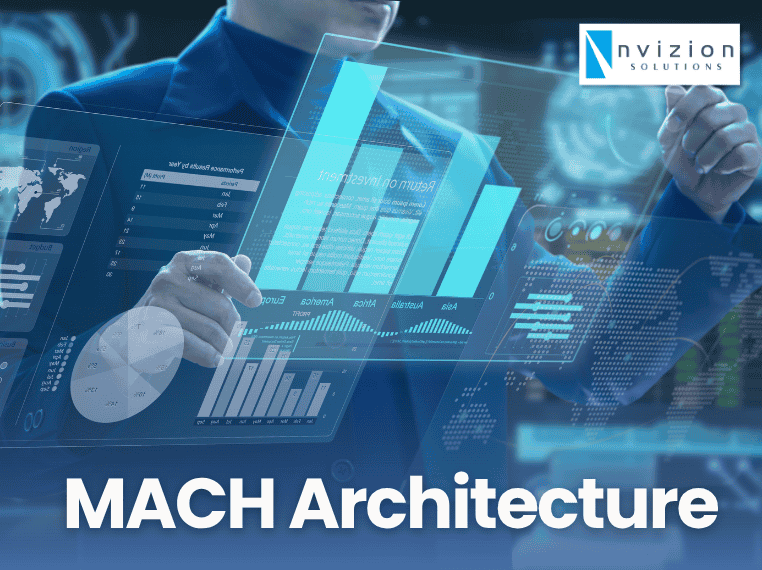What Is MACH Architecture and Why Is It Important?

What Is MACH Architecture and Why Is It Important?
In today’s fast-paced digital landscape, systems must be fast, scalable, and adaptable. As technology evolves rapidly and customer expectations rise, traditional monolithic systems often fall short. Enter MACH architecture — a modern, modular approach to designing future-ready digital platforms.
MACH stands for:
- Microservices
- API-first
- Cloud-native
- Headless
These four principles represent a shift away from tightly coupled, monolithic systems toward more modular, flexible, and scalable architectures. MACH breaks applications into independent components that can be developed, deployed, and updated individually.
The result? Systems that evolve faster, scale effortlessly, and integrate seamlessly — critical in industries like digital commerce, financial services, media, and healthcare, where speed and innovation are essential.
Why MACH Architecture Is Key to Digital Transformation
Traditional systems often limit innovation due to:
- Tightly coupled components
- Complex integrations
- Slow deployment cycles
- Inability to scale individual services
MACH architecture solves these problems by enabling:
- Faster innovation through modular development
- Agile responses to market shifts and customer behavior
- Omnichannel experiences from a unified backend
- Reduced operational risk via isolated service failures
- Cost efficiency with scalable, cloud-native infrastructure
By embracing MACH, businesses gain the flexibility to adapt quickly and compete more effectively.
Core Principles of MACH Architecture
1. Microservices
Microservices are the foundation of MACH. Instead of building one large application, functionalities are split into small, independent services, each responsible for a single business capability.
Benefits:
- Flexibility: Services can be updated or deployed independently.
- Resilience: A failure in one service doesn’t affect the entire system.
- Scalability: Resources are allocated based on each service’s needs.
Example:
In digital commerce, separate microservices might handle inventory, payments, search, and user authentication — each evolving on its own timeline.
2. API-First
In an API-first approach, all services are designed to be accessed through APIs. This ensures seamless communication and integration between systems, tools, and external partners.
Benefits:
- Interoperability: Different systems can easily connect and share data.
- Easy integration: New tools can be added without disrupting workflows.
- Developer efficiency: APIs are reusable across projects and platforms.
Example:
A commerce platform can integrate payment gateways, logistics partners, CRMs, and personalization tools — all via APIs.
3. Cloud-Native
Cloud-native applications are designed specifically for cloud environments, taking full advantage of scalability, automation, and managed services.
Benefits:
- Automatic scaling based on demand
- Built-in resilience with failover and disaster recovery
- Operational efficiency as teams focus on features, not infrastructure
Example:
During peak sales events, a cloud-native platform automatically scales up to handle traffic — and scales down when traffic subsides, reducing costs.
4. Headless
Headless architecture separates the front-end from the back-end, allowing content and data to be delivered via APIs to any device or channel.
Benefits:
- Omnichannel delivery: Content can be reused across web, mobile, kiosks, and wearables.
- Front-end freedom: Developers can use the latest frameworks and tools.
- Parallel development: Teams can build front-end and back-end independently.
Example:
A headless CMS lets marketing teams create content once and publish it across multiple platforms — saving time and reducing redundancy.
Benefits of Adopting MACH Architecture
Use Cases and Industry Adoption
MACH is gaining momentum across industries that demand fast, scalable, and consistent digital experiences:
- Digital Commerce: Real-time updates, personalized recommendations, and multichannel journeys
- Media & Entertainment: Low-latency delivery of rich content across devices
- Financial Services: Secure, integrated customer and transaction systems
- Healthcare & Life Sciences: Scalable platforms for patient data and digital health services
Challenges in Implementing MACH
While powerful, MACH architecture comes with challenges:
- Complexity: Managing multiple microservices and APIs requires strong governance.
- Specialized skills: Teams need expertise in cloud-native development, containerization, and API lifecycle management.
- Integration: Seamless communication between decoupled systems must be carefully designed.
Organizations that plan carefully, invest in training, and adopt the right technologies can overcome these challenges and unlock MACH’s full potential.
Why MACH Is No Longer Optional
MACH architecture provides the agility, scalability, and resilience needed to compete in the digital age. It empowers businesses to:
- Deliver faster innovation
- Enhance system performance
- Improve customer experiences
- Reduce operational overhead
- Future-proof digital infrastructure
As digital demands grow, MACH is not just a trend — it’s a necessity.
How Nvizion Helps
Nvizion enables organizations to adopt MACH architecture with customized, scalable solutions tailored to their business goals.
We specialize in:
- Designing microservices-based systems that accelerate innovation
- Implementing API-first architectures for seamless integration
- Deploying cloud-native infrastructure optimized for performance and cost-efficiency
With deep expertise in headless platforms and modern development practices, we ensure your MACH journey is both successful and sustainable.
